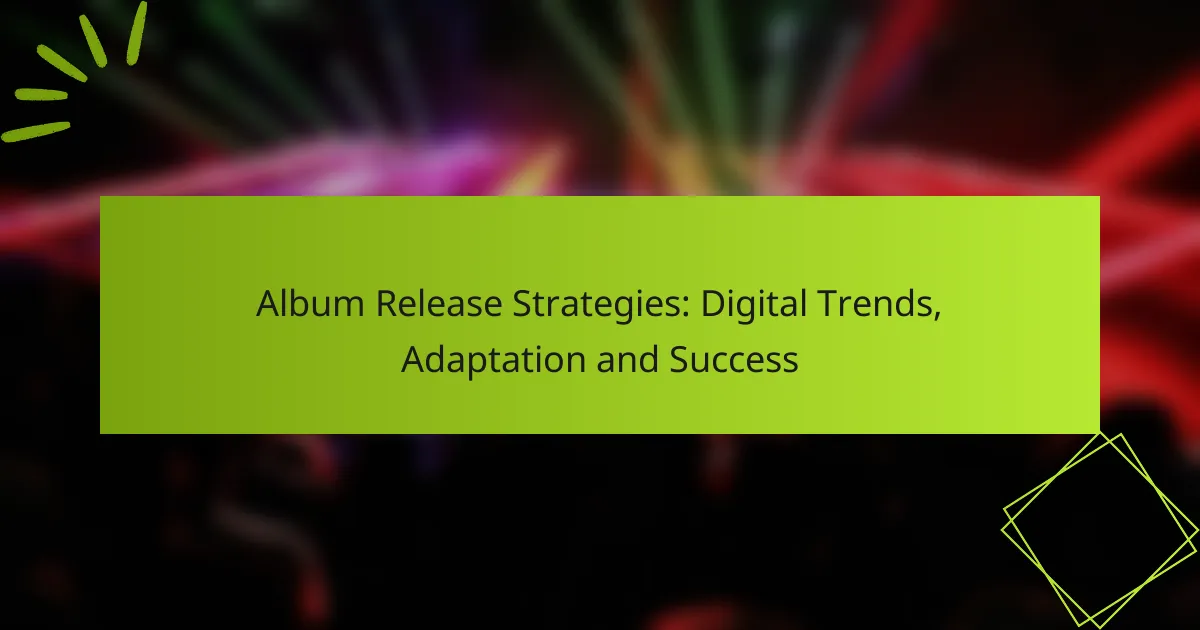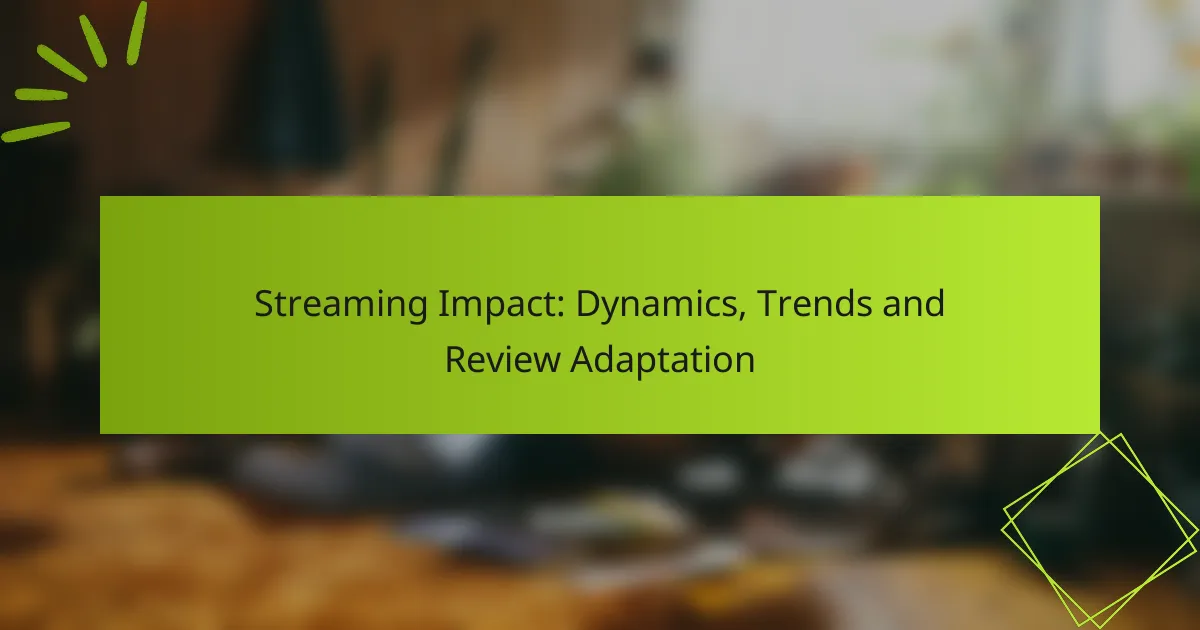In today’s digital landscape, effective album release strategies hinge on the smart use of online platforms and social media to boost visibility and engagement. By adapting to evolving trends and leveraging data analytics, artists can connect more deeply with their audiences while employing innovative promotional tactics to drive sales. Success is measured through key metrics such as streaming numbers, social media interactions, and overall fan retention, offering valuable insights into an album’s impact.
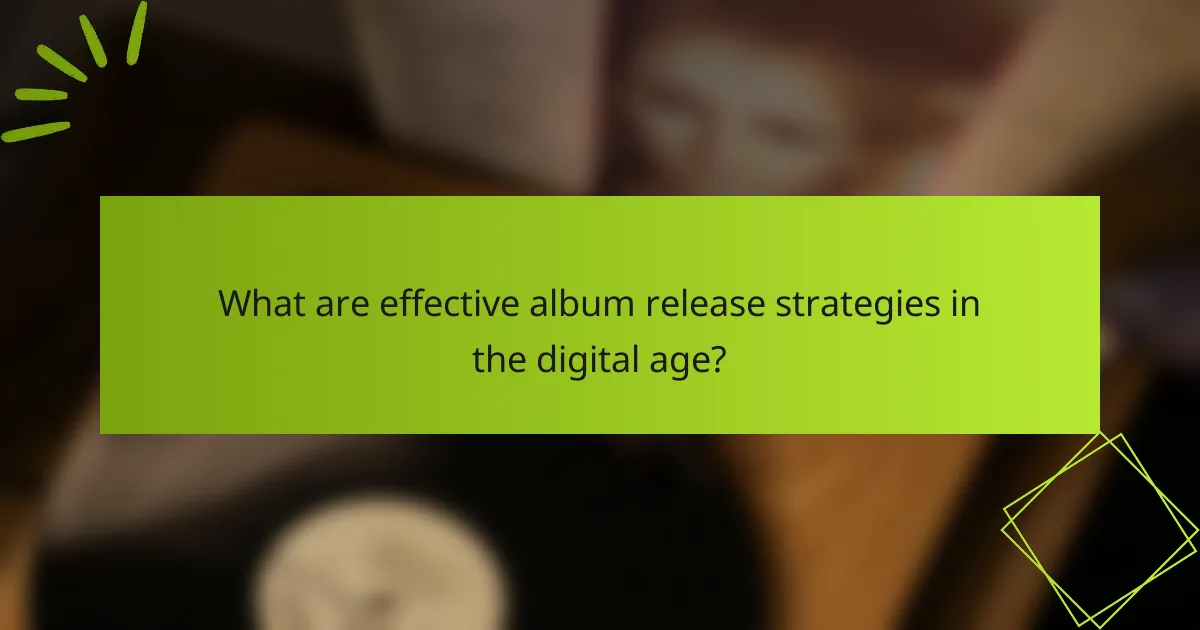
What are effective album release strategies in the digital age?
Effective album release strategies in the digital age focus on leveraging online platforms and social networks to maximize reach and engagement. By utilizing a combination of social media, streaming partnerships, and innovative promotional tactics, artists can enhance visibility and drive album sales.
Social media campaigns
Social media campaigns are essential for promoting album releases, as they allow artists to connect directly with fans. Platforms like Instagram, Twitter, and TikTok can be used to share teasers, behind-the-scenes content, and countdowns to the release date.
To maximize impact, artists should create engaging content that encourages sharing and interaction. Utilizing hashtags and collaborating with other artists can further expand reach and visibility.
Streaming platform partnerships
Partnering with streaming platforms like Spotify and Apple Music can significantly boost an album’s exposure. These platforms often feature new releases on their homepages or in curated playlists, which can lead to increased streams and listener engagement.
Artists should consider negotiating exclusive content or early access for their albums on these platforms, as this can create a sense of urgency and exclusivity among fans.
Influencer collaborations
Collaborating with influencers can amplify an album’s reach, as influencers often have dedicated followings that trust their recommendations. Artists can engage influencers to create content related to their album, such as reviews, unboxing videos, or promotional posts.
Choosing influencers whose audience aligns with the artist’s target demographic is crucial for effective collaboration. This ensures that the promotional efforts resonate with potential listeners.
Pre-save initiatives
Pre-save initiatives encourage fans to save an album before its release, boosting initial streaming numbers. Artists can promote pre-save links through social media and email newsletters, often incentivizing fans with exclusive content or merchandise.
Offering a clear call-to-action and making the pre-save process simple can significantly increase participation. This strategy not only builds anticipation but also helps secure a strong debut on streaming charts.
Virtual listening parties
Virtual listening parties allow artists to engage with fans in real-time during an album’s release. Platforms like Zoom or YouTube Live can be used to host these events, where artists can share insights about the album and answer fan questions.
Promoting the event ahead of time and creating an interactive experience can enhance fan engagement. Consider offering exclusive merchandise or giveaways during the party to encourage attendance and participation.
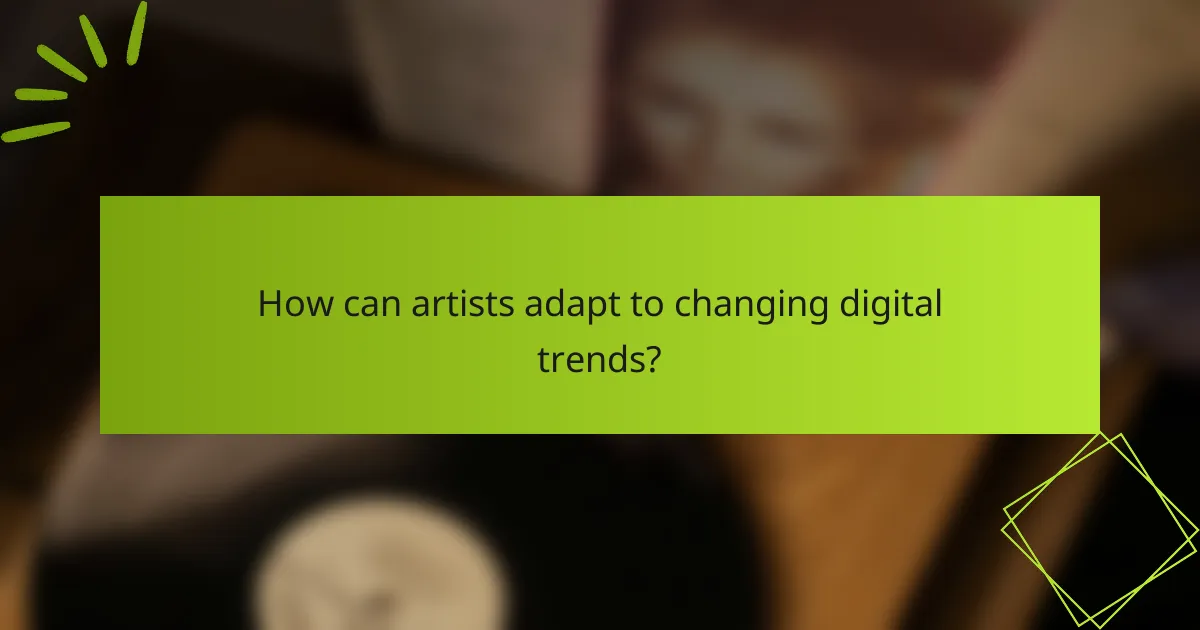
How can artists adapt to changing digital trends?
Artists can adapt to changing digital trends by leveraging technology and data to enhance their engagement with fans. This involves understanding audience preferences, utilizing analytics, and exploring innovative content formats to maintain relevance in a fast-evolving landscape.
Utilizing data analytics
Data analytics allows artists to gain insights into listener behavior and preferences. By analyzing streaming metrics, social media interactions, and sales data, artists can tailor their marketing strategies to better meet fan demands.
For instance, using platforms like Spotify for Artists or Apple Music Analytics can reveal which songs resonate most with audiences. This information can guide decisions on which tracks to promote or which demographics to target for future releases.
Engaging with fan communities
Building strong connections with fan communities is crucial for artists looking to thrive in the digital age. Engaging directly with fans through social media, live streams, and fan clubs fosters loyalty and creates a sense of belonging.
Artists can host Q&A sessions, share behind-the-scenes content, or even collaborate with fans on creative projects. This not only enhances fan engagement but also provides valuable feedback that can inform future releases.
Experimenting with content formats
Exploring various content formats can help artists stand out in a crowded digital marketplace. This includes experimenting with music videos, podcasts, live performances, and interactive experiences.
For example, creating short-form videos for platforms like TikTok can reach younger audiences effectively. Artists should consider the unique features of each platform to maximize engagement and reach.
Leveraging user-generated content
User-generated content (UGC) can significantly amplify an artist’s reach and authenticity. Encouraging fans to create and share their own content related to the artist’s music can lead to organic promotion and community building.
Artists can run contests or challenges that invite fans to share their interpretations of songs or dance routines. This not only engages the fanbase but also generates buzz around new releases, making fans feel like active participants in the artist’s journey.
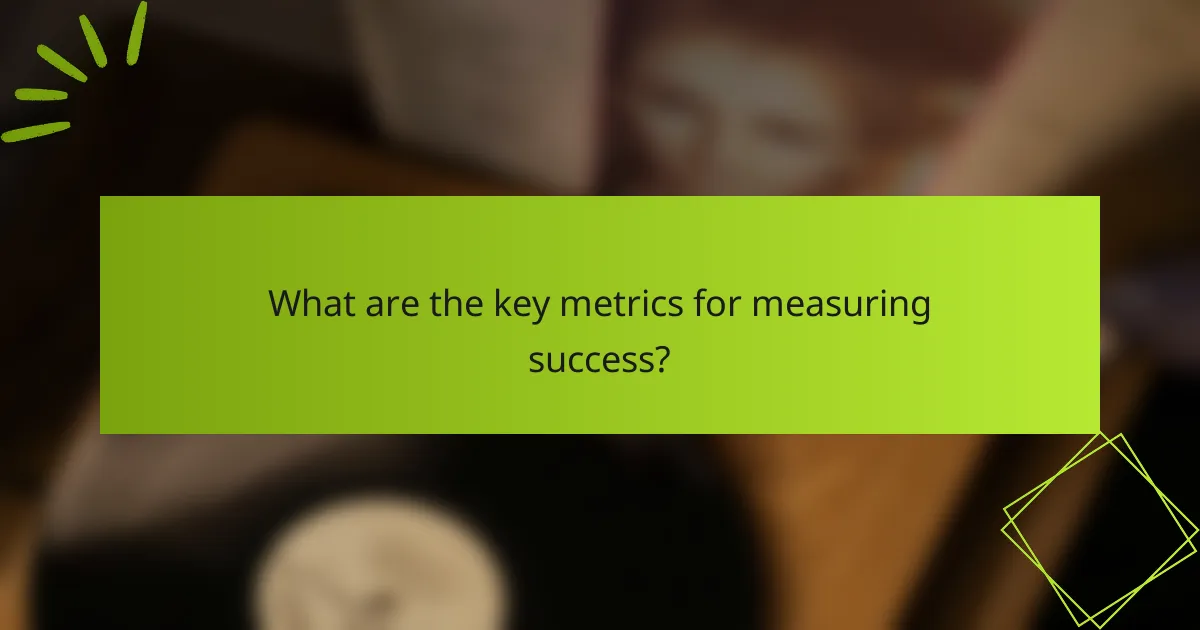
What are the key metrics for measuring success?
Key metrics for measuring success in album releases include streaming numbers, social media engagement, sales figures, and fan retention rates. These indicators provide insights into an album’s performance and the artist’s connection with their audience.
Streaming numbers
Streaming numbers reflect how often an album is played on platforms like Spotify, Apple Music, and YouTube. High streaming counts can indicate popularity and reach, often translating to increased visibility and potential revenue. Aim for tens of thousands to millions of streams within the first few weeks of release to gauge initial success.
Consider tracking not just total streams but also playlist placements and listener demographics. This data can help tailor future marketing strategies and identify target audiences more effectively.
Social media engagement
Social media engagement measures how actively fans interact with an artist’s content on platforms like Instagram, Twitter, and TikTok. Metrics such as likes, shares, comments, and follower growth are crucial for understanding fan interest and loyalty. A strong engagement rate, typically above 2-3%, can signal a healthy connection with the audience.
Utilize tools to analyze engagement trends over time, especially during album promotions. Engaging directly with fans through Q&A sessions or live streams can further boost interaction and loyalty.
Sales figures
Sales figures encompass both digital downloads and physical album sales. Tracking these numbers helps assess the financial success of an album. In the U.S., for example, achieving sales of 10,000 units in the first week is often considered a strong debut.
Keep in mind that sales figures can vary significantly by genre and market. Consider bundling albums with merchandise or concert tickets to enhance sales opportunities and provide added value to fans.
Fan retention rates
Fan retention rates indicate how well an artist maintains their audience over time. This metric can be assessed by analyzing repeat listeners, concert attendance, and merchandise purchases. A retention rate of 30-40% is generally a good benchmark for artists looking to build a loyal fanbase.
To improve retention, focus on creating engaging content and experiences for fans, such as exclusive releases or behind-the-scenes access. Regular communication through newsletters or social media can also help keep fans connected and invested in the artist’s journey.
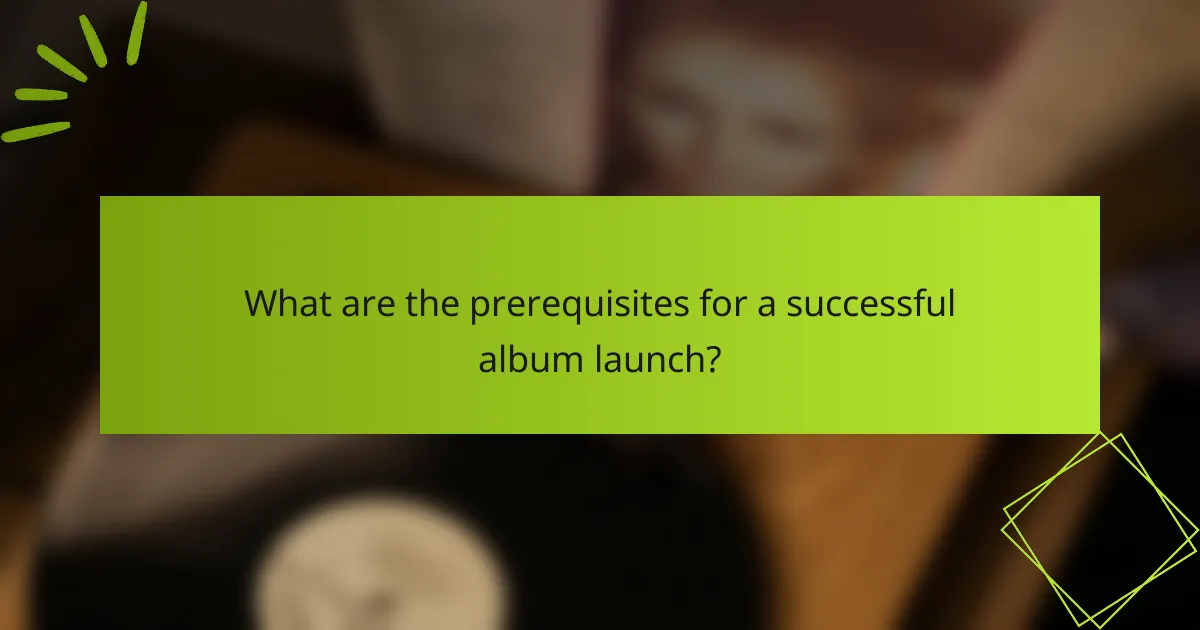
What are the prerequisites for a successful album launch?
A successful album launch requires thorough planning, market understanding, and strategic execution. Key prerequisites include conducting market research and identifying your target audience to ensure the album resonates with listeners.
Market research
Market research involves analyzing current trends, consumer preferences, and competitive landscapes in the music industry. This process helps artists and labels understand what genres, themes, and promotional strategies are currently effective.
Consider using surveys, social media analytics, and streaming data to gather insights. For instance, platforms like Spotify and Apple Music provide valuable information on listener demographics and popular playlists, which can guide your marketing approach.
Target audience identification
Identifying your target audience is crucial for tailoring your album’s content and marketing efforts. This involves defining the demographics, interests, and listening habits of potential fans.
Utilize tools like Google Analytics and social media insights to segment your audience. For example, if your music appeals to young adults aged 18-24, focus your promotional efforts on platforms like TikTok and Instagram where this demographic is most active.
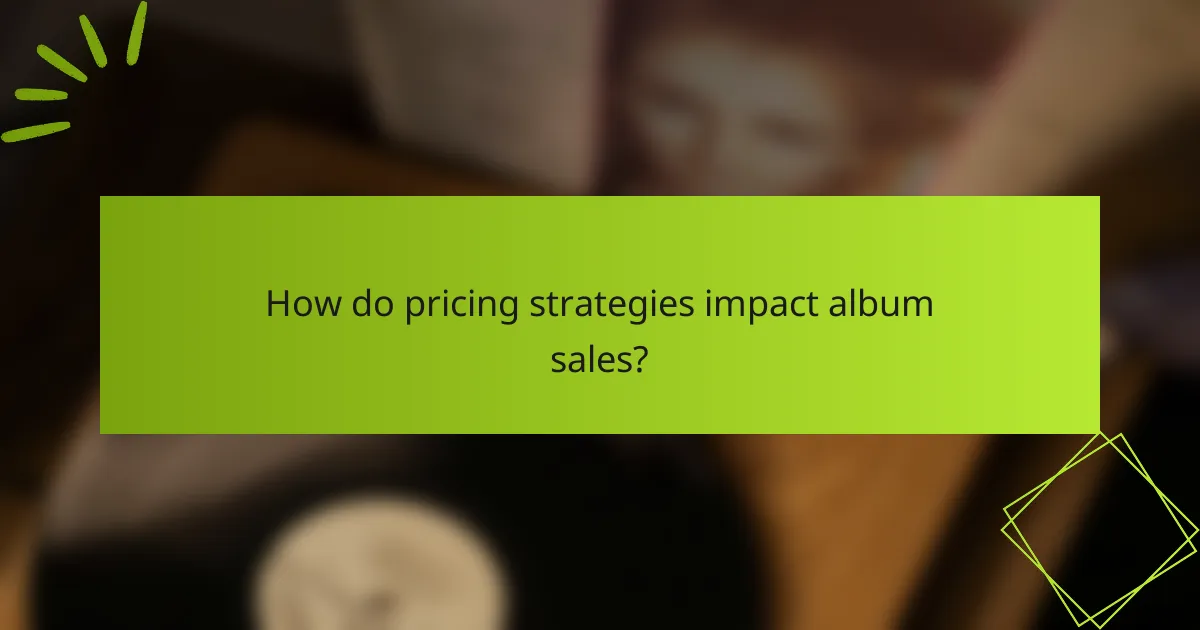
How do pricing strategies impact album sales?
Pricing strategies significantly influence album sales by affecting consumer perception and purchasing decisions. A well-structured pricing approach can enhance revenue, attract diverse audiences, and create competitive advantages in the music market.
Tiered pricing models
Tiered pricing models involve offering albums at different price points based on factors like format, exclusivity, or bundled content. For instance, a standard digital album might be priced lower than a deluxe edition that includes bonus tracks or exclusive artwork. This strategy allows artists to cater to various segments of their audience, maximizing potential sales.
Consider implementing three tiers: a basic digital download, a premium version with additional content, and a physical copy with special packaging. This approach can lead to increased revenue, as fans may opt for higher-priced options if they perceive added value.
Bundling with merchandise
Bundling albums with merchandise is an effective strategy to boost sales and enhance fan engagement. By offering items like t-shirts, posters, or concert tickets alongside the album, artists can create a more compelling package that appeals to fans. This method not only increases the perceived value but also encourages fans to purchase more than just the album.
For example, a bundle priced at $30 might include a digital album and a branded t-shirt, while the album alone could be priced at $15. This tactic can significantly increase average transaction values and foster a stronger connection between the artist and their audience.

What role do music videos play in album promotion?
Music videos are a crucial element in album promotion, serving as a dynamic tool to engage audiences and enhance visibility. They not only showcase the artist’s creativity but also help convey the themes and emotions of the album, making it more relatable to fans.
Visual storytelling
Visual storytelling in music videos allows artists to narrate a story that complements their music, creating a deeper connection with viewers. By using imagery, symbolism, and narrative arcs, artists can evoke emotions and convey messages that resonate with their audience.
For instance, a music video might depict a journey of love and loss, aligning with the album’s themes. This approach not only captivates viewers but also encourages them to share the video, expanding its reach across social media platforms.
To maximize impact, artists should consider the visual style, color palette, and cinematography that best reflect the album’s mood. Collaborating with skilled directors and creative teams can elevate the storytelling aspect, ensuring that the video resonates well with the target audience.
